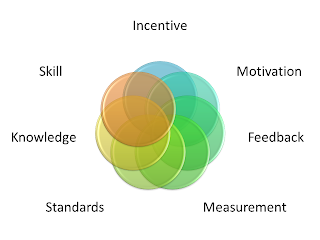ROI [3] - Cost Benefit Analysis - BENEFITS
When doing a Cost Benefit Analysis for training and education programs there are many factors that result in benefits and economic returns. Some of them are:
Of course the ROI chart would be just the opposite of the cost chart if all factors remained the same. The smallest ROI would be for the classroom delivery and the highest would be the web-cast. Again you must use caution in the presentation of this data. One type of delivery may be much more cost effective for a particular training intervention. Keep in mind that all of these charts will vary greatly with the number of learners, content, need, etc. It may be that the classroom delivery would be the most cost effective for a specific technical program because the cost of simulation software and development would be prohibitive. Look at every option every time. For a small number of learners the cost of classroom training is usually much more cost-effective.
See also:
ROI - The Process
ROI - 1 - (Return on Investment) - The Calculation
ROI - 2 - Cost Benefit Analysis - COSTS
ROI - 4 - The Four Evaluation Levels (Future)
- Labor
- Process efficiency
- Sales
- Management
- Time-to-fix
- Vendor costs
- Up-time
- Marketing costs
- Delivery efficiency
- Headcount
- Competitive advantage
- Market share
- OSHA (USA or local equivalent) - work safety agency
- EPA (USA or local equivalent) - environmental protection agency
- LABOR - Typically there are efficiency improvements. Do job better,quicker, less headcount.
- PROCESS EFFICIENCY - Same here; more product, less waste, quicker change-over, quicker start-ups, etc.
- SALES - more, higher margin, new market, customer satisfaction
- MANAGEMENT - fewer, can do more, better direction
- VENDOR COSTS - reduced through close project management, purchasing supply management better prepared
- DELIVERY EFFICIENCY - could be in terms of delivery type chosen (e-learning tends to be more cost effective) or for the delivery of your product: electricity, steam, installations, etc.
- HEADCOUNT - could look at in terms of fewer or less cost per head
- COMPETITIVE ADVANTAGE - would a short cycle time for the e-learning program give you a competitive advantage in time to market?
- MARKET SHARE - did you gain a couple market share points due to the learning
- OSHA - what is the benefit? few injuries (cost), employee awareness (better use of their time)
- EPA - no fine, fewer fines, less waste
 |
| Delivery costs for Training Programs - Lowest to Highest |
Of course the ROI chart would be just the opposite of the cost chart if all factors remained the same. The smallest ROI would be for the classroom delivery and the highest would be the web-cast. Again you must use caution in the presentation of this data. One type of delivery may be much more cost effective for a particular training intervention. Keep in mind that all of these charts will vary greatly with the number of learners, content, need, etc. It may be that the classroom delivery would be the most cost effective for a specific technical program because the cost of simulation software and development would be prohibitive. Look at every option every time. For a small number of learners the cost of classroom training is usually much more cost-effective.
 |
| ROI for a Training Program for different delivery types |
ROI - The Process
ROI - 1 - (Return on Investment) - The Calculation
ROI - 2 - Cost Benefit Analysis - COSTS
ROI - 4 - The Four Evaluation Levels (Future)


Comments
Post a Comment